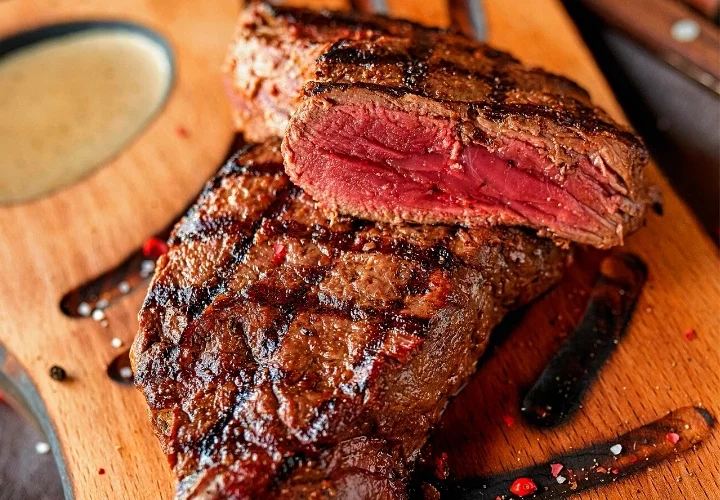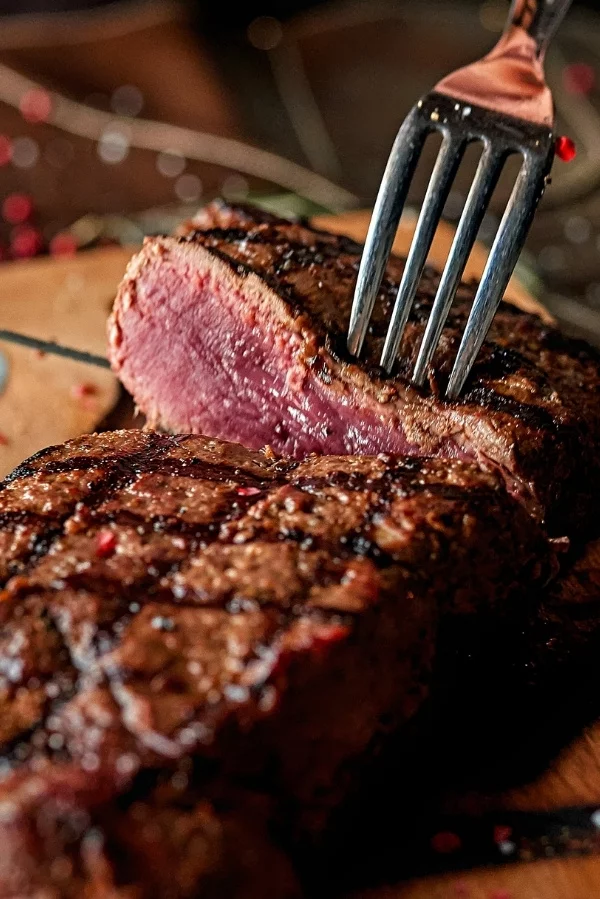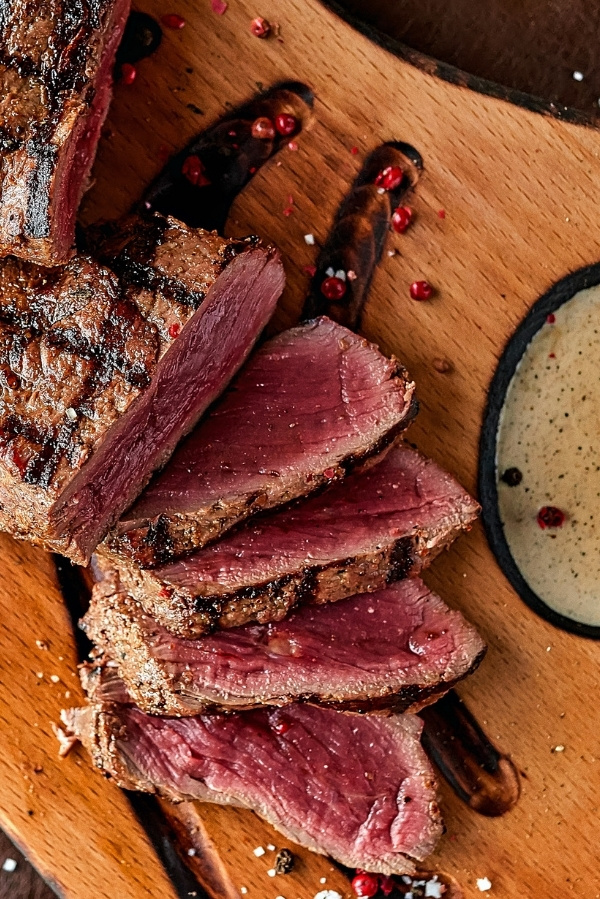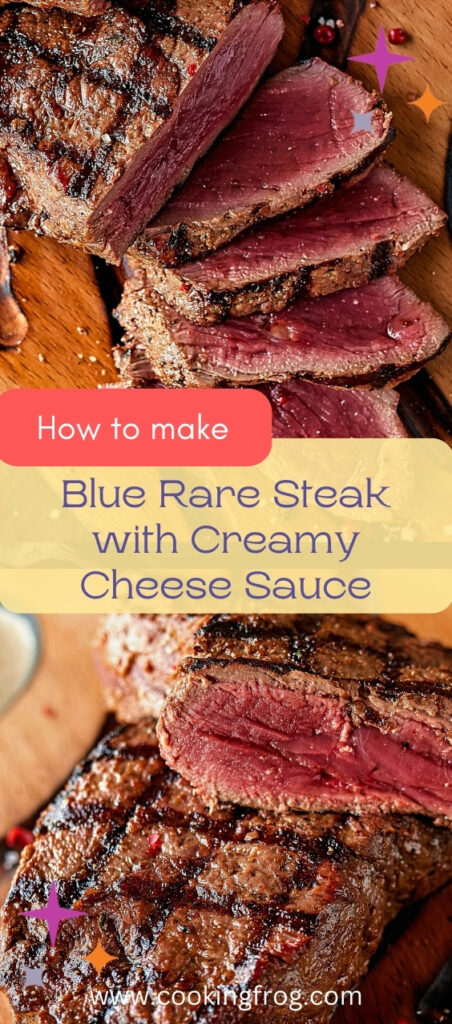Blue steak, commonly referred to as blue rare steak or extra rare steak, is a steak with a light outside searing and crimson inside. To achieve this, blue steak is cooked for a brief period. As a result, the steak is soft and supple, ideal for individuals who want a melt-in-your-mouth experience.
Understanding what blue steak is and how to prepare it is essential whether you’re getting ready to launch a butcher shop or searching for new methods to prepare the steaks in your restaurant.
A blue steak can appear not even on the grill if you believe a rare steak was not cooked enough. A blue steak is prepared extremely rare and just shy of being served raw.
Since the myoglobin is oxygenated from the moment the meat is cut until you purchase it from the butcher, it becomes red when exposed to air and loses its blue tint. A blue steak is seared on the exterior and entirely red within, as opposed to a rare steak, which is seared on the outside and approximately 75% red inside. A blue steak doesn’t cook on the grill for very long.
Although other Blue stake recipes call for an internal temperature of 84F, I will not do that in this recipe, just out of concern for your safety. The steak’s inner temperature should not be more than 115F to 120F.
You might wonder if it’s safe to eat, given how uncooked the steak tastes and how it tastes. We’ll get to that shortly, but first, let’s look at the origin of the name “Blue Steak.”
Why Is It Called a Blue Steak?
Here, we’ll be upfront with you. Although it’s difficult to give a precise response, we know some of the motivations for the name. These are several hypotheses; however, not all are supported by evidence.
First Reson: Blood Oxygenation
Some claim that the first time the flesh is chopped, it turns blue. The meat’s blue tint changes to a rich scarlet after being out in the air for a while.
That theory is based on the fact that human blood contains oxygen. Our arteries are red because the blood has oxygen, but our veins are blue because the blood does not. This makes sense initially, but it also means that a blue steak will bleed when sliced.
This is when the notion is disproven since cooked flesh does not bleed. Myoglobin, not blood, emerges from your delicious steak when you cut it.
Second Reason: The Blue Sheen
According to this notion, the steak’s oils have a blue sheen that gives the impression that the inside is cool or blue.
In other words, it’s merely giving the steak a fancy name based on what some could mistake for a blue shine. Are you as skeptical about that as we are?
Third Reason: French “Au Bleu”
I believe that this is the most plausible hypothesis. Fish that has just been caught and cooked is known as Au Bleu in French culture.
Cooking fish with a combination of herbs and vinegar is particularly frequent when preparing trout. The technique is known as “Au Bleu Trout.”
The phrase “blue” or “bleu” steak is used when a steak is barely cooked to the point that it still appears raw.
Blue Steak Taste
Now when you’re ready to eat, what flavor should you anticipate? Your bite will feel reasonably normal for the initial half of it. You’re chewing into a steak with a well-seasoned, brown-seared surface that is identical to any other steak.
When you reach the “bleu” interior, the unique adventure begins. You might be surprised by the abrupt change from warm, flavorful meat to a chilly middle. Sometimes people describe it as spongy because it lacks the juicy bite you receive when you bite into a medium-rare steak.
The flavor is distinctive, but not everyone will enjoy it. Like Sushi, for example, some folks just don’t like sushi, but others love it. Blue steak has ardent supporters who believe it to be the finest steak available. Not every meat lover will immediately like this, in general. Since this is an acquired taste, it could take some time. However, with my delicious cheese sauce recipe, I’m sure you’ll love it.
Is it safe to eat Blue Steak?
No one wants a wonderful steak supper ruined by an unnecessary ER visit due to E. coli contamination. The quick answer to whether it’s safe to eat blue steak is unambiguous “yes,” and here’s why.
Researchers at the University of Nottingham tested whether consuming a steak laced with E. coli bacteria would result in the bacteria remaining after the meat was cooked to a rare temperature (source BBC).
They discovered that, although there was still bacteria in the steaks after the slices were removed off the grill, it was due to the serving tongs and not the brief time there. No E. coli was found in the meat when the blue steaks were turned using sanitized tongs.
Consuming a carefully prepared blue steak is safe, even though eating raw or undercooked food can be hazardous. Steaks should be served with an interior temperature that is at least 140 ℉ for maximum safety.
And although rare steaks are frequently served below this temperature, you might want to include a disclaimer on your menu informing customers that eating undercooked or raw meats, shellfish, poultry, seafood, or eggs increases the risk of contracting a foodborne disease.
Safety Advice for Blue Steak
Blue steaks need to be cooked according to food safety regulations in order to be safe to eat. For instance, after handling raw meat with tongs, you should carefully wipe and sanitize them to prevent disease.
To ensure that pathogens like E. coli are eradicated, you should also ensure that your steak’s exterior is properly seared before serving.
What is Black and Blue Steak or Pittsburgh Blue Steak?
A Pittsburgh blue steak or a Pittsburgh-style steak are other names for black and blue steaks. The Pittsburgh steel mills during the industrial period are where the moniker “Pittsburgh steak” originated.
According to legend, employees at steel mills used to bring steaks to work for lunch and cook them on the hot plant machinery. The workers could cook the steaks during their brief lunch breaks since the heated industrial equipment instantly charred the surface of the steak while leaving the interior crimson.
You might also like this recipe: Blackstone Griddle T-bone Steak Easy Recipe
The Best Cuts for Blue Steak
The fat in a steak dissolves during cooking, and the crystal is broken down. A blue rare steak is cooked for a short time, which results in slight melting of the fat. Therefore, the best choices for cooking blue steak are lean slices with low fat. When preparing your blue steak, you could choose to use one of the following cuts:
Sirloin Tip – The round, the area behind the cow’s back leg, is where the sirloin tip is cut. This cut is less soft than tenderloin and flat iron steaks because of the position of the cut, which contains some weight-bearing muscle. This sirloin tip offers a superior alternative to blue steak since it is flavorful and still pretty soft.
Tenderloin – Tenderloin is a cut taken from the cow’s loin. There is hardly any fat or tissue on the wound since this body area is not a muscle-bearing area. Due to its extreme tenderness, tenderloin is one of the best beef cuts for blue steaks.
Chuck or Shoulder (flat iron steaks) – A cow’s chuck or shoulder portion is where flat iron steaks are sourced from. According to many, the second-most tender cut after the tenderloin is flat iron steak. Because they were thought to be of poor quality and worthless, flat iron steaks were formerly referred to as “butler steaks.” Recent developments have made it possible to remove connective tissue from the cut, creating the soft flat iron we are all familiar with today.
Ingredients You Will Need For Blue Steak with Cheese Sauce
The steak and cheese sauce, which is made with Gorgonzola, Pecorino Romano, and heavy cream, are the three fundamental components of this recipe. Don’t worry if you dislike blue cheese or want to substitute another sauce or seasoning! The recipe for the steak component works well on its own.
For the Blue Steak:
Sirloin Steak: I used sirloin, sliced to a thickness of 1.5 to 2 inches. (Other steak alternatives are listed below.)
Olive oil and butter: When used together, the butter may cook at a higher temperature and imparts a deep, robust taste to the steak.
Rosemary: To balance the richness of the steak and butter, a sprig of fresh rosemary offers a strong, earthy flavor.
Thyme: Thyme is a herb that is frequently used in beef-based meals. Thyme will simply balance the flavors and provide a touch of depth that only herbs can offer, whether it is used fresh or dried.
Garlic: You’ll need an entire head of garlic for this recipe!
Salt and Pepper: And, of course, salt and pepper for seasoning.
For the Cheese Sauce
Heavy Cream: A silky cheese sauce’s ideal foundation is heavy cream.
Blue cheese: The blue cheese of your choosing, such as Gorgonzola.
Pecorino Romano: Pecorino Romano will blend amazingly with this sauce.
Salt and pepper: For seasoning the sauce
I strongly advise using a kitchen timer or the clock application on your phone to time this steak because it just has to be cooked for a minimum period. If you exceed the allotted time, you could still get a delicious rare steak, but it won’t be blue.
STEP 1: Let the steak rest. Start by grabbing your steak 30 minutes in advance and leaving it out to reach room temperature. As a simple dry rub, season the steak with salt and pepper while doing it.
STEP 2: Sear the first side of the steak. Set a large cast-iron pan over high heat after 30 minutes. The pan must be quite hot. Place the steak in the pan when the oil starts to smoke after you’ve added a tablespoon of it. To get a decent sear, it has to cook for 2 minutes and 30 seconds on the first side.
STEP 3: Add butter, garlic, rosemary, and thyme to the steak as it is seared on the second side. After the 2 minutes and 30 seconds are up, carefully turn the steak and add the butter, rosemary, and garlic head to the pan. Cook the steak for precisely 2 minutes, basting it often with butter and pan juices.
STEP 4: More rest. After removing the steak from the pan, place it on a fresh serving dish. At room temperature, it needs to rest for 35 minutes. It can be lightly tented with foil if you need to cover it.
STEP 5: Prepare the Cheese Sauce. Making the blue cheese sauce involves combining the cheeses and cream in a small pot over low heat while the steak rests. Once the ingredients are well blended into a sauce, stir in salt and pepper to taste. Remove the heated sauce from the stove.
Serve and enjoy! With your chosen side dishes, serve the cheese sauce and blue steak.
Expert Tips for the Best Blue Steak Recipe
These are my top recommendations for preparing blue steak at home. There are definitely oddities in this strange recipe! Who knew, for instance, that a great blue steak should be lean rather than marbled? Right, continue reading for that advice as well as more.
Steer clear of marbling: Typically, a nice steak is tender and has good marbling. Why? Because throughout the cooking process, the marbled fat melts, hydrating and tenderizing the steak.
Yum! However, since the steak won’t be cooked for very long in this instance, the fat won’t melt. If you’re cooking blue, avoid a well-marbled steak to avoid dealing with chewy, unrendered white fat.
Don’t Skip the Rest Time: If you cook a blue steak straight from the refrigerator, the inside will probably be chilly. A sufficient rest time before cooking will bring the flesh to room temperature, giving you a warm but still blue steak.
Be prepared for smoke: A screaming hot pan is necessary for a nice sear that leaves the interior of your steak blue. This indicates that you may anticipate cooking in a lot of smoke, which is fantastic! Make sure the exhaust fan on your stove is functioning.
Add the Cheese Sauce: Since the steak doesn’t have time to marinate or acquire a strong taste in any other way, it makes a delicious companion for a beautiful sauce. Pecorino Romano, blue cheese, and blue steak? Yes, they are a perfect fit.
If you like this article on Blue Steak, please share the image below to your Pinterest board!
Blue Steak with Cheese Sauce Recipe
Ingredients
For the Blue Steak:
- 2 pounds of sirloin steak
- 1 TBSP of olive oil
- 4 TBSP of butter
- 1 rosemary sprig
- 2 tsp of fresh thyme, chopped
- 1 garlic head, cut crosswise in half
- Salt and pepper
For the Cheese Sauce:
- 1 cup of heavy cream
- ⅔ cup of blue cheese
- ¼ cup of Pecorino Romano cheese
- Salt and pepper
Instructions
For the Blue Steak
- Rub the blue steak with salt and pepper, then let it aside for half an hour to come to room temperature.
- Set a large cast-iron pan on high heat. Add a spoonful of olive oil. The steak should be placed in the skillet when the oil begins to smoke and cook for precisely 2 minutes and 30 seconds.
- Carefully rotate the steak once the required time has passed. Next, butter, rosemary, thyme, and garlic, should all be added to the skillet. Cook for precisely two minutes, and baste the steak often with butter and pan juices.
- Use an instant-read thermometer to determine the steak’s temperature. When it reads 115 degrees Fahrenheit, it’s cooked. When you lightly push the steak, your index finger will feel soft and spongey.
- The steak should be taken from the skillet and put on a fresh tray or serving dish. Allow it to rest for 35 minutes at room temperature under a loose foil tent.
For the Cheese Sauce
Melt the cheeses and cream in a small saucepan on low heat while the steak rests. Cheese and cream are cooked while being constantly stirred. Add pepper and salt to taste when seasoning.
Nutrition
- Calories: 700kcal
- Carbohydrates: 2.1g
- Protein: 57g
- Fat: 51g
- Saturated Fat: 28g
- Monounsaturated Fat: 16g
- Polyunsaturated Fat: 2g
- Trans Fat: 0.4g
- Cholesterol: 248mg
- Potassium: 886mg
- Sodium: 451mg
- Fiber: 0.04g | Sugar: 2g
- Vitamin A: 1370IU
- Vitamin C: 1mg
- Calcium: 206mg
- Iron: 4mg
Conclusion
Since blue steak is the finest and most delicate way to cook a steak, it is a must-have item on the menus of steakhouses and eateries. Now you can make it at home with this amazing cheese sauce. Just be careful and follow the safety guidelines on cooking the meat.
So, if you’ve liked this Blue Steak recipe, please share it with your friends on your social media, and be sure to let me know how you like the recipe in the comments section.





